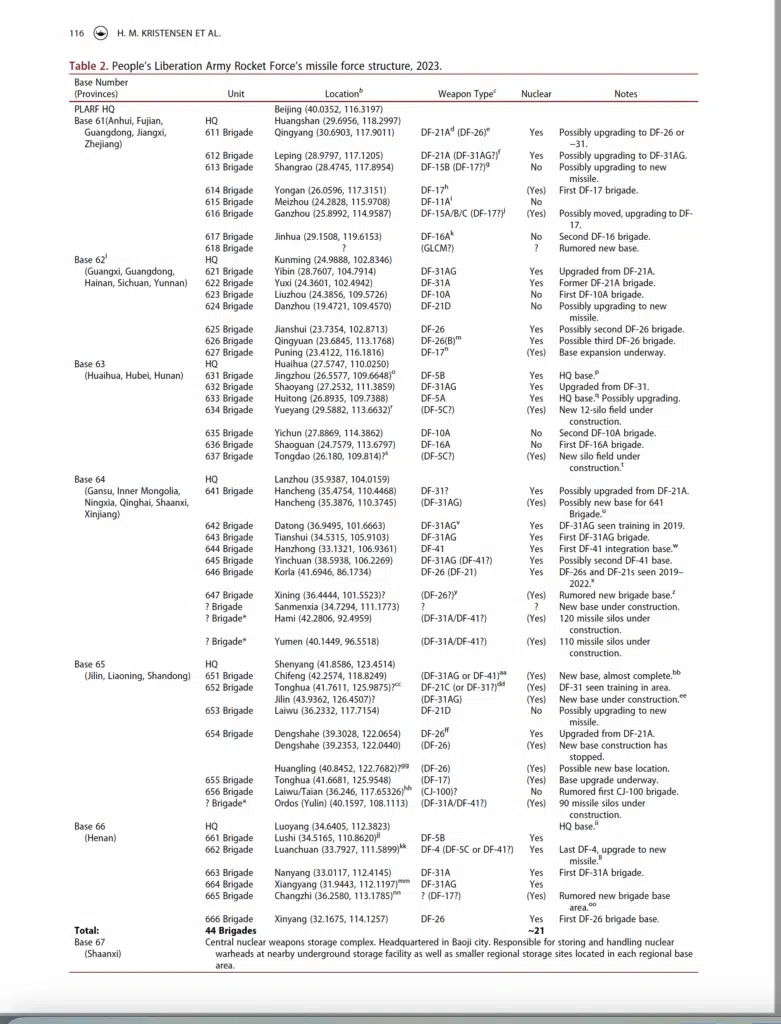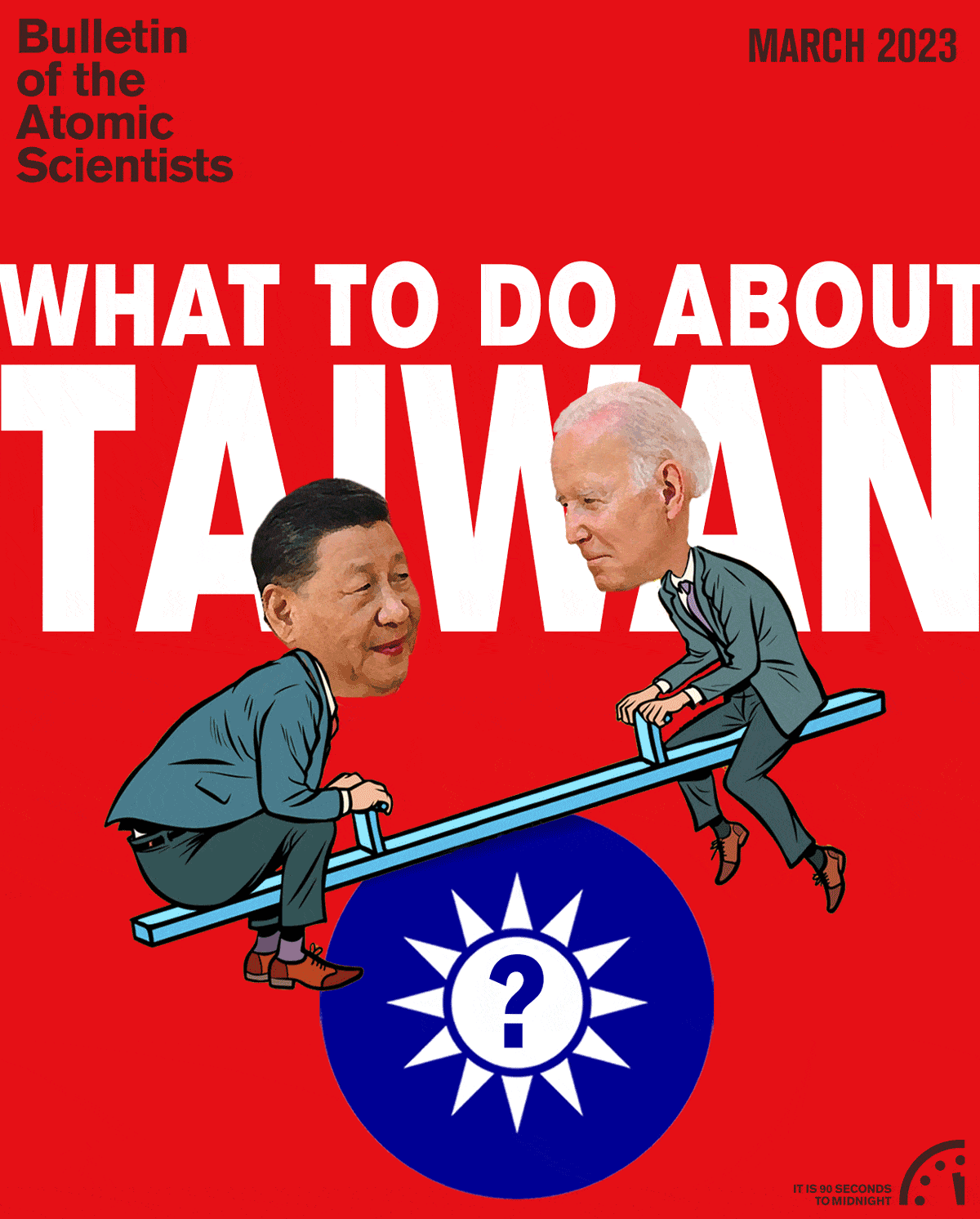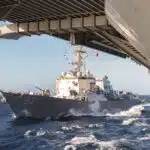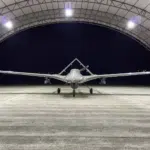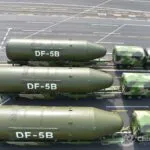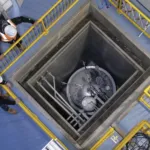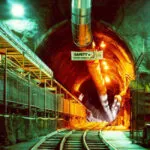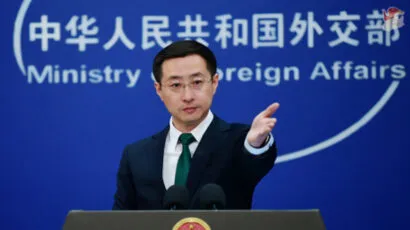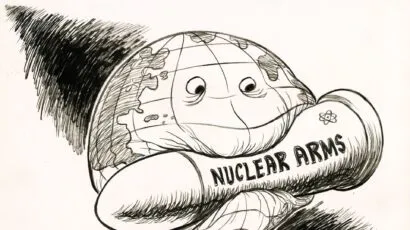Nuclear Notebook: Chinese nuclear weapons, 2023
By Hans M. Kristensen, Matt Korda, Eliana Johns | March 13, 2023
Nuclear Notebook: Chinese nuclear weapons, 2023
By Hans M. Kristensen, Matt Korda, Eliana Johns | March 13, 2023
The Nuclear Notebook is researched and written by the staff of the Federation of American Scientists’ Nuclear Information Project: director Hans M. Kristensen, senior research associate Matt Korda, and research associate Eliana Reynolds. The Nuclear Notebook column has been published in the Bulletin of the Atomic Scientists since 1987. This issue’s column examines China’s nuclear arsenal. We estimate that China’s stockpile now includes roughly 410 nuclear warheads with more in production. The stockpile is expected to increase significantly in the next decade but remains significantly smaller than that of Russia or the United States.
This article is freely available in PDF format in the Bulletin of the Atomic Scientists’ digital magazine (published by Taylor & Francis) at this link. To cite this article, please use the following citation, adapted to the appropriate citation style: Hans M. Kristensen, Matt Korda, and Eliana Reynolds, Chinese Nuclear Weapons, 2023, Bulletin of the Atomic Scientists, 79:2, 108-133, DOI: https://doi.org/10.1080/00963402.2023.2178713
To see all previous Nuclear Notebook columns, go to https://thebulletin.org/nuclear-notebook/
China is continuing the nuclear weapons modernization program that it initiated in the 1990s and 2000s, but is expanding it significantly by fielding more types and greater numbers of nuclear weapons than ever before. Since our previous Nuclear Notebook on China in November 2021, China has continued to modernize its road-mobile intercontinental ballistic missile (ICBM), has significantly advanced the construction of its three new missile silo fields for solid-fuel ICBMs, and has also expanded the construction of new silos for its liquid-fuel DF-5 ICBMs. China is also significantly expanding its DF-26 intermediate-range ballistic missile force and has also begun replacing some older conventional short- range ballistic missiles with new DF-17 medium-range ballistic missiles equipped with hypersonic glide vehicles. At sea, China apparently has refitted its six Type-094 ballistic missile submarines with the longer-range JL-3 submarine-launched ballistic missile. In addition, China has recently reassigned a nuclear mission to its bombers and is developing an air-launched ballistic missile that might have nuclear capability.
We estimate that China has produced a stockpile of approximately 410 nuclear warheads for delivery by land-based ballistic missiles, sea-based ballistic missiles, and bombers. Additional warheads are thought to be in production to eventually arm additional road-mobile and silo-based missiles and bombers (see Table 1). The Pentagon’s 2022 report to Congress estimated that by 2030 China’s nuclear stockpile “will have about 1,000 operational nuclear warheads, most of which will be fielded on systems capable of ranging the continental United States” (US Department of Defense 2022a, 97). If expansion continues at the current rate, the Pentagon projected, China might field a stockpile of about 1,500 nuclear warheads by 2035 (US Department of Defense 2022a, 94, 98).
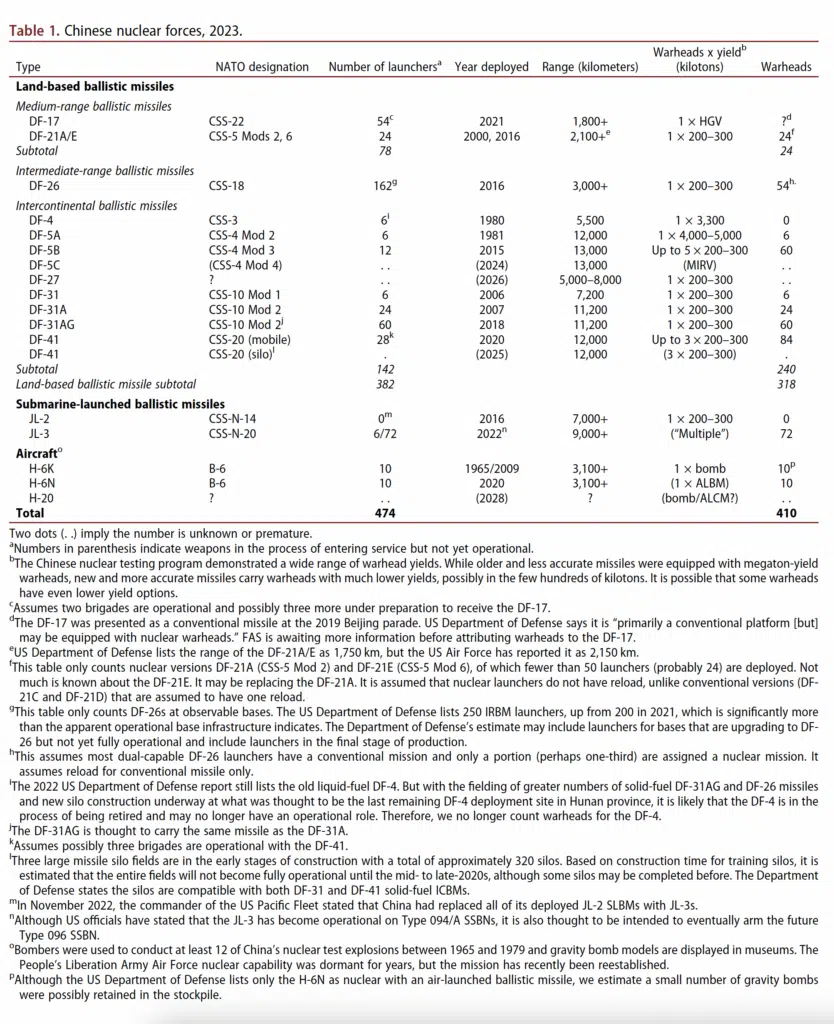
These projections, however, have yet to fully materialize. They depend on many uncertain factors, including how many missile silos will be built, how many warheads each missile will carry, and assumptions about the future production of fissile materials by China. US estimates for China’s nuclear weapons stockpile have been wrong several times already in the past (Figure 1). Current US projections appear to simply apply the same increase rate of new warheads added to the stockpile between 2019 and 2021 to the subsequent years until 2035.
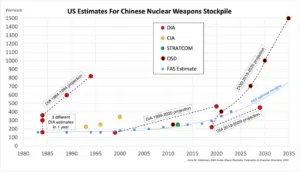
Fissile materials production
How much and how fast the stockpile can grow will depend upon China’s inventories of plutonium, highly enriched uranium, and tritium. The current inventories can easily support a doubling of the stockpile, but producing more than 1,000 additional warheads would probably require production of additional material. Currently, there are few constraints on China’s ability to develop or acquire highly enriched uranium and tritium, and the Pentagon assesses that China is expanding and diversifying its capability to produce tritium (US Department of Defense 2022a, 97).
China could potentially be limited by its current plutonium stocks since production of weapon-grade plutonium reportedly ceased in the mid-1980s (Zhang 2018). However, Beijing is combining its civilian technology and industrial sector with its defense industrial base to leverage dual-use infrastructure (US Department of Defense 2022a, 27). It is technically possible, therefore, for China to acquire significant stocks of plutonium by using its civilian reactors, including two commercial-sized CFR-600 sodium-cooled fast-breeder reactors that are currently under construction at Xiapu in Fujian province and are scheduled to come online in 2023 and 2026 (Von Hippel 2021; Jones 2021; Zhang 2021a); however, other countries have encountered technical difficulties operating fast-breeder reactors in the past.
To extract plutonium from its spent reactor fuel, China has nearly completed its first civilian “demonstration” repossessing plant at the CNNC Gansu Nuclear Technology Industrial Park in Jinta, Gansu, which is expected to be operational in 2025. China has started the construction of a second plant in the same location, which should be up and running before the end of the decade (Zhang 2021b). These reprocessing plants and the mixed oxide (MOX) fuel fabrication line also located in Jinta could support the plutonium needs of the two CFR-600 reactors, though the first CFR-600 reactor will begin operation with HEU rather than MOX due to a prior supply agree- ment with Russia (Zhang 2021b) (Figure 2).
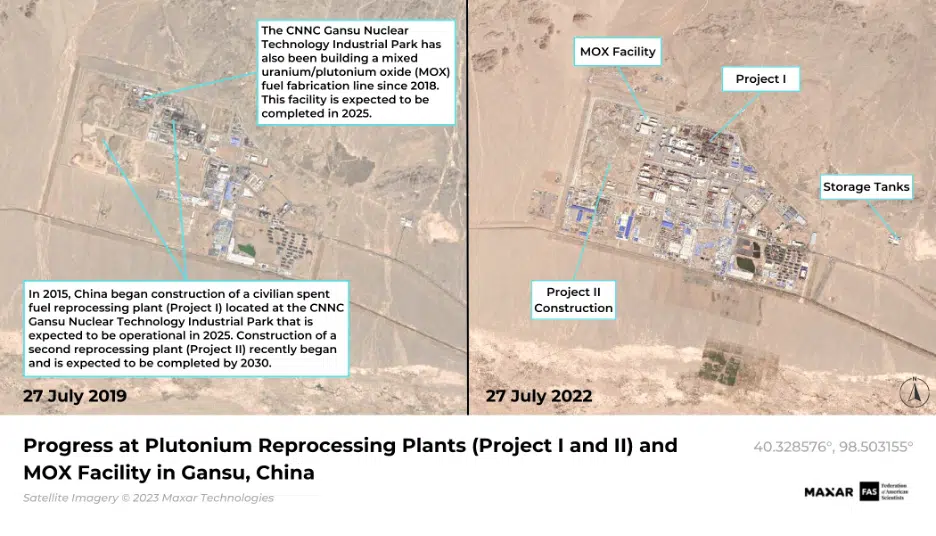
The ambiguity of Chinese warhead types and the amount of fissile material required for the designs pose a challenge for estimating how many weapons China could produce from its existing highly enriched uranium (HEU) and weapons-grade plutonium stockpiles (Tellis 2022, 40). Once the new fast-breeder reactors come online, they could potentially produce large amounts of plutonium and, by some estimates, could enable China to acquire up to over 330 kilograms of weapon-grade plutonium annually for new warhead production (Kobayashi 2022; US Department of Defense 2022a, 96–97).
China’s production and reprocessing of fissile materials is consistent with its nuclear power efforts and its goal of reaching a closed nuclear fuel cycle. A 2021 report from the Nonproliferation Education Policy Center concluded that there is no indication “that Beijing necessarily intends to divert these huge quantities of plutonium to weapons, but that it could do so and might yet choose to” (Ford and Countryman 2021). However, the US Department of Defense believes that the increase in China’s capacity for producing and separating plutonium will very likely be used to expand its nuclear weapons program (US Department of Defense 2022a, 96). Transparency of China’s nuclear materials production and its suspected expansion of uranium and tritium production has recently decreased as China has not reported its separated plutonium stockpile to the IAEA since 2017.
US estimates and assumptions about Chinese nuclear forces
Evaluation of current US projections about the future size of China’s nuclear weapons stockpile must keep in mind earlier projections, some of which did not come to pass. During the 1980s and 1990s, US government agencies published several projections for the number of Chinese nuclear warheads. A US Defense Intelligence Agency study from 1984 inaccurately estimated that China had 150 to 360 nuclear warheads and projected it could increase to more than 800 by 1994 (Kristensen 2006). Over a decade later, another Defense Intelligence Agency study published in 1999 projected that China might have over 460 nuclear weapons by 2020 (US Defense Intelligence Agency 1999). That projection also did not come true. When the Pentagon in 2020 finally publicly disclosed its estimate of the Chinese nuclear warhead inventory, it was less than half of what the Defense Intelligence Agency had projected two decades earlier: “in the low 200s” (US Department of Defense 2020a, ix; Figure 1).
With this record in mind, current US projections should be taken with a grain of salt. In April 2021 the commander of US Strategic Command, Adm. Charles Richard, testified before Congress saying that China is “well ahead of the pace necessary to double their nuclear stockpile by the end of the decade” (Richard 2021b). A couple of months earlier, in January 2021, Richard wrote in US Naval Institute Proceedings that the Chinese stockpile could “triple or quadruple” over the next decade (Richard 2021a). And in November 2021, the Pentagon’s annual report to Congress projected that China could have 700 deliverable warheads by 2027, and possibly as many as 1,000 by 2030 (US Department of Defense 2021, 90).
The 2022 Pentagon increased the projection even further, claiming that China’s stockpile of “operational” nuclear warheads had surpassed 400 and will likely reach about 1,500 warheads by 2035 (US Department of Defense 2022a, 94). The spokesperson for China’s Ministry of National Defense, Senior Colonel Tan Kefei, responded to the report saying that the Pentagon was “distorting China’s national defense policy and military strategy, groundlessly speculating about China’s military development” (Li 2022).
Although China’s nuclear plans have many uncertainties, expansion is not one of them. The Chinese spokesperson did not dismiss or explain the construction of three large missile silo fields that by Chinese standards constitute an unprecedented nuclear expansion. Even the expansion of the mobile ICBM force is unprecedented.
The Pentagon’s latest projections appear to assume that China intends to deploy many missiles capable of carrying multiple independently targetable reentry vehicles (MIRVs) in the new silos. However, there are several unknowns. First, how many of the new silos will be loaded? China might build more silos than missiles to create a “shell game” that would make it harder for an adversary to target the missiles. Second, how many of the missiles will be MIRVed, and with how many warheads? Each DF-5 ICBM can carry up to five warheads, and the Pentagon assesses that the DF-41 ICBM will likely carry no more than three MIRVs (US Department of Defense 2022a, 94).
The main purpose of the massive silo construction program probably is to safeguard China’s retaliatory capability against a surprise first-strike, and the main purpose of the MIRV program is probably to ensure penetration of US missile defenses, rather than to maximize the warhead loading of the Chinese missile force. As the United States strengthens its offensive forces and missile defenses, China will likely further modify its nuclear posture to ensure the credibility of its retaliatory strike force, including deploying hypersonic glide vehicles.
The projected increase has unsurprisingly triggered a wide range of speculations about China’s nuclear intentions. In 2020, Trump administration officials suggested that “China no longer intends to field a minimal deterrent,” and instead strives for “a form of nuclear parity with the United States and Russia” (Billingslea 2020). These statements were echoed in August 2021 by the Deputy of US Strategic Command, who stated that: “There’s going to be a point, a crossover point, where the number of threats presented by China will exceed the number of threats that currently Russia presents,” noting that this point would likely be reached “in the next few years” (Bussiere 2021). In April 2022, the commander of the US Strategic Command, Adm. Charles Richard, referred to China’s expansion of its strategic and nuclear forces as “breathtaking,” later stating that China was intent on pursuing a “world-class military by 2030, and the military capabilities to seize Taiwan by force, if they choose to, by 2027” (US Strategic Command 2022). He also referred to China’s “investments in nuclear command and control” and “nascent launch under warning, launch under attack” capabilities as clear signs that they have improved their readiness and “moved a long way off the historic minimum-deterrence posture” (US Strategic Command 2022).
Based on what we can observe of the silo construction program and the expansion of the mobile ICBM force, it seems possible that China’s ICBM force could potentially exceed that of either Russia or the United States a decade from now. Even so, the entire Chinese arsenal—even if the stockpile quadrupled in size—would still only make up a fraction of US and Russian stockpiles.
The Chinese government uses the disparity in total warhead numbers to argue it is “unrealistic to expect China to join [the United States and Russia] in a negotiation aimed at nuclear arms reduction” (Ministry of National Defense of the People’s Republic of China 2020). And US defense officials have their own response when reminded about China’s much smaller nuclear warhead inventory: “We don’t approach it from purely a numbers game,” according to the deputy commander of the US Strategic Command, Lt. Gen. Thomas Bussiere. “It is what is operationally fielded, . . . status of forces, posture of those fielded forces. So, it is not just a stockpile number” (Bussiere 2021). Secretary of Defense Lloyd Austin went even further in 2022 when he described the new defense strategy of integrated deterrence, saying that “deterrence has never been just about the numbers, the weapons, or the platforms” (US Department of Defense 2022b).
Nuclear testing
The projection for how much the Chinese nuclear stockpile will increase also depends on the size of its warheads. The nuclear weapons testing program of the 1990s partially supported development of the warhead(s) currently arming the DF-31 ICBMs. This warhead may also have been used to MIRV the liquid-fueled DF-5B, replacing the much larger warhead used on the DF-4A and DF-4 missiles. The large DF-41 and the JL-3 could potentially use the same warhead. Fielding of a smaller warhead would likely require additional nuclear tests.
The US Department of State’s 2022 Compliance Report assesses that some of China’s actions at its Lop Nur nuclear testing site “raise concern” about China’s adherence to the United States’ “zero-yield” standard (US Department of State 2022, 29). However, the report does not explicitly accuse China of conducting tests that produced a yield, nor does it present any evidence to that effect. Instead, the report echoes the previous years’ findings that “[China]’s lack of transparency regarding the nature of its testing activities raise concerns regarding [China]’s adherence to its testing moratorium” (US State Department 2022, 29). Open-source satellite imagery analysis has subsequently indicated that China appears to be expanding the Lop Nur site, with the construction of approximately a dozen concrete buildings near the Lop Nur airfield, as well as a possible new tunnel at the test site itself (Brumfiel 2021b). Satellite imagery shows what appears to be new drainage areas, roads, spoil piles, and covered entrances (Brumfiel 2021a). Those structures remained visible as of September 2022. If China did conduct low-yield nuclear tests at Lop Nur, it would violate its responsibility under the Comprehensive Test Ban Treaty, which it has signed but not ratified. However, it is not clear that such testing would give it a military advantage.
Nuclear doctrine and policy
China’s official policy identifies self-defense and counter-strike response as key guidelines for its military strategy and reiterates a historical commitment to no-first-use of nuclear weapons (Ministry of National Defense of the People’s Republic of China 2022). Since its first nuclear test in 1964, China has maintained a minimum nuclear deterrence posture and emphasized that a credible second-strike capability would be sufficient to deter an attack on China. In his speech to the UN General Assembly First Committee session on nonproliferation in October 2022, China’s ambassador for disarmament affairs Li Song claimed that China “keeps its nuclear capabilities at the minimum level required for national security and does not engage in any nuclear arms race with any other country” (Li 2022).
However, China’s significantly expanding nuclear arsenal challenges these claims. China has never defined how big a “minimum” capability is or what activities constitute an “arms race,” and the policies evidently do not prohibit a massive expansion in response to other nuclear-armed states. The posture apparently seeks to “adapt to the development of the world’s strategic situation,” part of which involves the “organic integration nuclear counterattack capability and conventional strike capability” (China Aerospace Studies Institute 2022, 381–382).
This involves investing significant resources to ensure the survivability of the nuclear arsenal, including practicing “nuclear attack survival exercises” to ensure that troops could still launch nuclear counterattacks if China were to be attacked (Global Times 2020). The People’s Liberation Army (China’s principal military force) has maintained a “low alert level” for its nuclear forces and keeps most of its warheads at its regional storage facilities and its central storage facility in the Qinling mountain range. [1]
The 2022 Pentagon report reaffirmed this posture, stating that China “almost certainly keeps the majority of its nuclear force on a peacetime status—with separated launchers, missiles, and warheads.” But the report also described that the People’s Liberation Army Rocket Force brigades conduct “combat readiness duty” and “high alert duty” drills, which “apparently includes assigning a missile battalion to be ready to launch and rotating to standby positions as much as monthly for unspecified periods of time” (US Department of Defense 2022a, 95). Some Chinese military officials have reportedly advocated for increasing the readiness of China’s nuclear missiles (Kulacki 2016).
Increased readiness and alert drills do not necessarily require nuclear warheads to be installed on the alert missiles or prove that they are installed all the time. A nuclear attack against China is unlikely to come out of the blue and is more likely to follow a period of increasing tension and conventional warfare, allowing the warheads to be mated to the missiles in time. In April 2019, the Chinese delegation to the Preparatory Committee for the 2020 Review Conference of the Parties to the Treaty on the Nonproliferation of Nuclear Weapons provided a generic description of its alert posture and the stages Chinese nuclear forces would go through in a crisis:
The command of the nuclear force in China is highly centralized. Unit operations must be carried out in the strictest and most accurate compliance with the orders of the Central Military Commission. In peacetime, the nuclear force is maintained at a moderate state of alert. In accordance with the principles of peacetime-wartime coordination, constant readiness, and being prepared to fight at any time, China strengthens its combat readiness support to ensure effective response to war threats and emergencies. If the country faced a nuclear threat, the alert status would be raised and preparations for nuclear counter-attack undertaken under the orders of the Central Military Commission to deter the enemy from using nuclear weapons against China. If the country were subjected to nuclear attack, it would mount a resolute counter-attack against the enemy (emphasis added) (Ministry of Foreign Affairs of the People’s Republic of China 2019).
The “moderate state of alert” in peacetime might involve designated units to be deployed in high combat-ready condition with nuclear warheads in nearby storage sites under control of the Central Military Commission that could be released to the unit quickly if necessary.
The Pentagon assesses that China’s construction of new silo fields indicates its intent to move to a launch-on-warning (LOW) posture to increase the peacetime readiness of its nuclear forces (US Department of Defense 2022a, 100). The Pentagon elaborates that part of the LOW posture involves implementing an “early warning counterstrike” strategy, relying on space and ground-based sensors that would warn of an enemy missile strike that would give China time to launch its missiles before they would be destroyed (US Department of Defense 2022a, 99).
As part of this effort, the Pentagon expects that the People’s Liberation Army Rocket Force (PLARF) will continue to conduct exercises involving “early warning of a nuclear strike and launch-on-warning responses” (US Department of Defense 2022a, 99). In 2021, US Department of State officials noted: “Since 2017 [the People’s Liberation Army] has also conducted exercises involving launch-on-warning, and now has deployed at least one satellite into orbit for its [LOW] posture” (Joshi 2021a). In its 2022 report, the Pentagon assessed that China “likely has at least three early warning satellites in orbit” (US Department of Defense 2022a, 99).
In addition to the technical means for protecting the missiles against a first strike, the PLARF has also emphasized “survival protection” for its land-based nuclear forces (China Aerospace Studies Institute 2022, 386). This involves training soldiers to perform additional tasks beyond their primary roles, including a “role switch” where a transporter erector launcher (TEL) driver would also know how to launch a missile, or a measurement specialist who knows how to command (Baughman 2022). During one “survival protection” training exercise in November 2021, a launch battalion was informed they would be “killed” by an enemy missile strike in five minutes. Rather than attempting to evacuate—the standard “survival protection” procedure—the battalion commander ordered his troops to conduct a surprise “launch on the spot” of their ballistic missile before the enemy missile hit their position (Lu and Liu 2021; Baughman 2022). While the report did not specify whether the battalion had a nuclear or conventional strike role, the results of the exercise suggest that the PLARF is practicing launching missiles in a launch-on-warning scenario.
These data points, however, are not necessarily evidence of a shift to a more aggressive nuclear posture. They could just as likely be intended to ensure the survival of the forces against a surprise first strike. China has deployed silo-based DF-5s and road-mobile ICBMs for decades that in a crisis would be armed with the intention to launch them before they are destroyed. China potentially could maintain its current strategy even with many new silos and improved early-warning systems. The combination of silo-based solid-fuel missiles and early warning could be interpreted as a Chinese reaction to what it sees is an increasing risk against the survivability of its retaliatory nuclear force.
Both the United States and Russia operate large numbers of solid-fuel silo-based missiles and early-warning systems to be able to detect nuclear attacks and launch their missiles before they are destroyed. Furthermore, both countries insist that such a posture is both necessary and stabilizing. It seems reasonable to assume that China would seek a similar posture to safeguard its own retaliatory capability.
A Chinese early-warning system could potentially also be intended to enable a future missile defense system to intercept incoming missiles. The latest Pentagon report on China’s military capabilities notes that China is developing an indigenous HQ-19 hit-to- kill mid-course missile defense system that could engage intermediate-range ballistic missiles and possibly ICBMs, although the latter would still take many years to develop (US Department of Defense 2022a, 61). China already maintains several ground-based large phased-array radars that contribute to its nascent early-warning capabilities. The PLA continues to substantially invest in and improve its intelligence, surveillance, and reconnaissance (ISR) infrastructure and is reportedly progressing in its development of a space-based early warning capability, potentially with Russia’s help (US Department of Defense 2022a, 89, 99). Whatever the purpose, if China develops an early warning system in the future, it will almost certainly sooner or later produce false alarms about non-existent attacks and potentially trigger dangerous reactions— emergencies that Russian and US early-warning systems have encountered numerous times.
China’s nuclear modernization—particularly, the construction of hundreds of silos for solid-fuel missiles and the development of an “early warning counter-strike” strategy—has triggered accusations about China’s no-first-use policy. In February 2020, for example, the commander of US Strategic Command testified to Congress that he could “drive a truck through that no-first-use policy.” After criticism, he later walked back the statement, saying it was based upon “very little” insight into how China interprets its own no-first-use policy (Richard 2020b). But after the open-source disclosures of the massive silo construction, Adm. Richard again challenged the policy: “These capabilities bring into question China’s stated ‘No First Use’ policy declaration and implied minimum deterrent strategy” (Richard 2021b, 7).
Although there has been considerable discussion in China about the size and readiness of the nuclear arsenal as well as when the no-first-use policy would apply, there is no evidence to suggest that the Chinese government has deviated from these longstanding policies (Santoro and Gromoll 2020). Additionally, during the October 2022 UN General Assembly First Committee session on nonproliferation, Chinese ambassador Li reaffirmed the policy: “China has solemnly committed to no first use of nuclear weapons at any time and under any circumstances, and not using or threatening to use nuclear weapons against non-nuclear-weapon states or nuclear-weapon-free zones unconditionally” (Li 2022).
There is no public evidence that China is implementing plans to conduct a bolt-from-the-blue first strike with nuclear weapons. Below that extreme scenario, however, it remains unclear what could cause the Chinese leadership to order the use of nuclear weapons. In the past, Chinese officials have privately stated that China reserves the right to use nuclear weapons if its nuclear forces were attacked with conventional weapons. Such use would constitute first use of nuclear weapons. In previous years, the Pentagon had stated that there was “no indication that national leaders are willing to attach such nuances and caveats to China’s existing [no-first-use] policy,” but this assessment was not included in the Pentagon’s latest 2022 report (US Department of Defense 2020a, 86).
Regardless of what the specific red lines may be, China’s no-first-use policy probably has a high threshold. Chinese doctrine reportedly is very clear that although the alerting process could take place before an enemy nuclear strike, a Chinese nuclear strike would only take place “after the enemy has carried out a nuclear attack against our country” (Kulacki 2020).
The 2022 Pentagon report confirms that: “China’s nuclear strategy probably includes consideration of a nuclear strike in response to a nonnuclear attack threatening the viability of China’s nuclear forces or [Command and Control system], or that approximates the strategic effects of a nuclear strike. Beijing would probably also consider nuclear use to restore deterrence if a conventional military defeat gravely threatened [China]’s survival” (US Department of Defense 2022a, 95). With these considerations, many believe there are very few scenarios in which China would benefit strategically from a first strike even in the case of conventional conflict with a military power such as the United States (Tellis 2022, 27).
In addition to declaratory policy, the modernization of the nuclear forces could gradually influence Chinese nuclear strategy by offering more efficient ways of deploying and responding with nuclear forces. The 2022 US Nuclear Posture Review suggests that China’s trajectory of expanding and improving its nuclear arsenal could “provide [China] with new options before and during a crisis or conflict to leverage nuclear weapons for coercive purposes, including military provocations against U.S. Allies and partners in the region” (US Department of Defense 2022c, 4). Yet, there is so far no public indication that China’s nuclear strategy is more aggressive or adventuristic. Instead, the Pentagon assesses that the PLA most likely prioritizes conflict de-escalation when considering nuclear strike targets and would probably seek to avoid an extended series of nuclear exchanges against a superior adversary (US Department of Defense 2022a, 95).
Land-based ballistic missiles
China is continuing the long-term modernization of its land-based, nuclear-capable missile force, but the pace and scope of this effort has increased significantly with the construction underway of approximately 350 new missile silos and several new bases for road-mobile missile launchers. Overall, we estimate that the People’s Liberation Army Rocket Force currently operates approximately 380 launchers for land-based missiles that can deliver nuclear warheads. Of those missiles, approximately one-third—about 130—can reach the continental United States. [2] Most of China’s ballistic missile launchers are for short-, medium-, and intermediate- range missiles intended for regional missions, and most of those are not nuclear. We estimate there are about 75 nuclear warheads assigned to regional missiles.
China’s land-based ballistic missile force is directed by the People’s Liberation Army Rocket Force (PLARF), which is headquartered in Beijing. The PLARF controls nine individually numbered bases: six for missile operations distributed across China (Bases 61 through 66), one for overseeing the central nuclear stockpile (Base 67), one for maintaining infrastructure (Base 68), and one that is assumed to be for training and missile tests (Base 69) (Xiu 2022, 2). Each missile operating base controls six to eight missile brigades, with the number of launchers and missiles assigned to each brigade depending on the type of missile (Xiu 2022, 5).
To accommodate the growing missile force, the total number of Chinese missile brigades has increased too. This increase is predominantly caused by the growing inventory of conventional missiles, but it is also a product of China’s nuclear modernization program. According to one study, the number of ballistic missile brigades increased by over 35 percent between 2017 and 2020, and some of those (as well as new brigades) remain under construction (Singer and Xiu 2020). The transparency of China’s missile force has been greatly enhanced in recent years by the unique work of Decker Eveleth (Eveleth 2020b) and the US Air Force’s China Aerospace Studies Institute. Based on that work and other information, we estimate that the People’s Liberation Army Rocket Force currently has approximately 44 brigades with ballistic or cruise missile launchers. Of those brigades, approximately half operate ballistic missile launchers with nuclear capability, a number that is likely to grow further as bases currently under construction are completed (see Table 2). Russia, in comparison, operates about 50 nuclear brigades (known as regiments in the Russian military) (Kristensen and Korda 2020b).
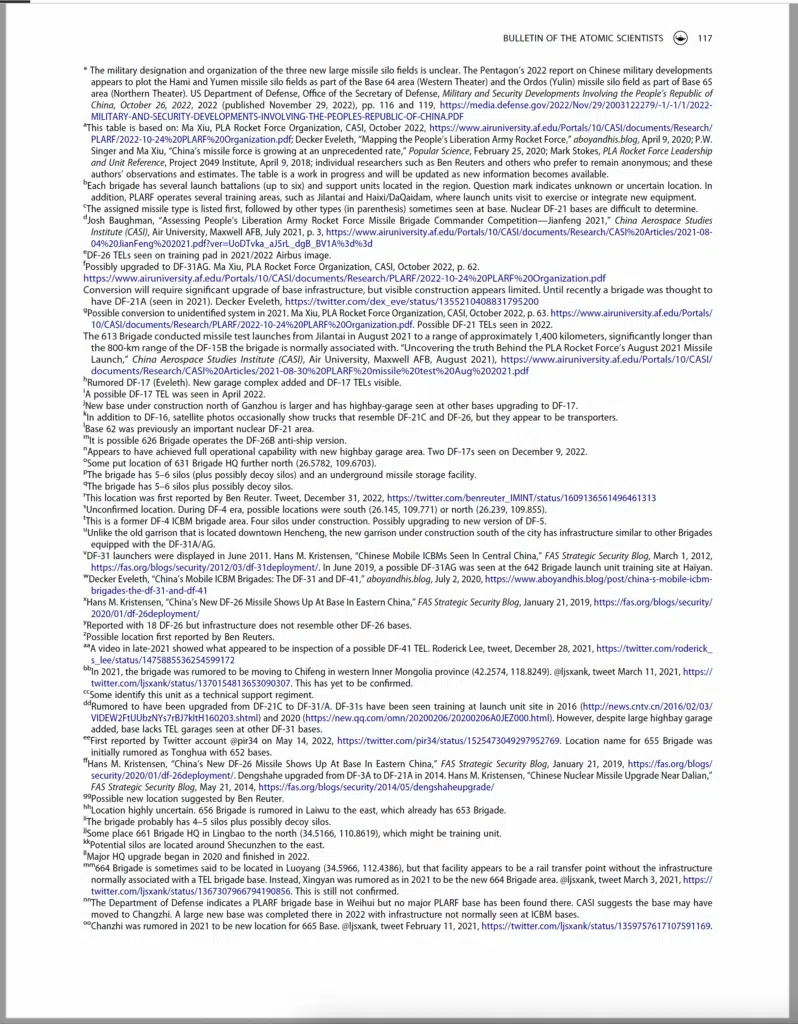
Intercontinental ballistic missiles
The most significant recent development in China’s nuclear arsenal is the construction of what appears to be approximately 350 new missile silos in three desert areas across northern China and in three mountainous areas of central-eastern China. Over the past few years, open-source researchers had documented the modernization of missile silos and training areas across China in locations like Sundian, Wuzhai, and Jilantai, but it remained unclear how these silos might be operationalized (Dill 2018; Kristensen 2019b; LaFoy and Eveleth 2020). In February 2021, the Federation of American Scientists’ Hans Kristensen noted the presence of distinctive inflatable shelters covering multiple suspected silo headworks at Jilantai, along with telltale semi-circle wall structures which would be used to build the silo walls (Kristensen 2021). These signatures helped other open-source researchers discover additional construction related to China’s missile program, with the eventual discovery of three sizable silo fields across northern China.
The construction progression for each individual silo is easily observable using satellite imagery, and typically proceeds as follows: a space for each silo headworks is cleared, then a large inflatable shelter is erected before large-scale excavation begins. The shelter has a dual- functionality: protecting the silo construction from the elements—including frequent desert sandstorms and cold fronts—as well as from the prying eyes of satellite imagery analysts. Occasionally the silo hole—or part of it—is excavated first and the shelter is erected over it before the silo components are installed. Several satellite images show semi-circle structural forms that may be lowered into the hole and assembled to form the silo walls during this phase. Several months later, the shelter is removed, and construction continues in the open-air with less sensitive auxiliary structures.
Throughout its silo construction period, China has experimented with several different types of shelters—including inflatable short rectangular domes, long rectangular domes, and round domes, as well as solid rectangular structures—for each silo field. The reason for this likely has to do with practical construction issues, such as the availability of materials, cost, and construction footprint, rather than what is being constructed under them. At each one of the three missile fields—as well as the training site at Jilantai—the silos are positioned roughly three kilometers apart in an almost perfect triangular grid pattern.
The silo fields are located deeper inside China than any other known ICBM base, and beyond the reach of the United States’ conventional and nuclear cruise missiles. On several separate occasions, different elements of the US government validated the open-source assessment that the construction sites were indeed missile silo complexes (US Strategic Command 2021; Lendon and Gan 2021; Joshi 2021b).
Yumen silo field
In June 2021, Decker Eveleth disclosed the presence of construction sites for likely missile silos near the northwestern city of Yumen, in China’s Gansu province (Warrick 2021; Lewis and Eveleth 2021). The missile field contained dozens of inflatable shelters identical to those visible at Jilantai. Satellite imagery appeared to confirm that the complex would ultimately contain missile silos, as hatch fixtures became clearly visible after the shelters were removed.
The Yumen silo field covers an area of approximately 340 square miles (1,110 square kilometers), with a perimeter fence surrounding the entire complex. The field includes 120 individual silos. There also appear to be at least five launch control centers scattered throughout the field, which are connected to the silos through a series of buried underground cables.
In addition to the 120 silos, the Yumen field also includes dozens of supporting and defensive structures. These include multiple security gates in the north (40.38722° N, 96.52416° E) and south (40.03437° N, 96.69658° E), at least 23 support facilities, and approximately 20 electrical or radio towers. Additionally, the Yumen field includes at least five raised square platforms around the perimeter of the complex, which could possibly be used for early warning or air and missile defense.
Construction of the field began in March 2020 and the last inflatable shelter was removed in February 2022, indicating that the most sensitive construction on each silo has now been completed. Construction at the Yumen field is the furthest along out of the three silo complexes, and it is likely that the other two fields will likely follow a similar pattern and timeline.
Hami silo field
In July 2021, an additional 110 construction sites for likely missile silos near Hami, in Eastern Xinjiang, were disclosed by the Federation of American Scientists’ Matt Korda (Broad and Sanger 2021; Korda and Kristensen 2021). The Hami field spans an area of approximately 390 square miles (1,010 square kilometers), roughly the same size as the Yumen field, and also has a perimeter fence around the entire complex.
The Hami silo field is currently at a later stage of development compared to the Yumen field, with construction thought to have begun at the start of March 2021—roughly one year after Yumen. The last of the field’s inflatable domes was removed in August 2022.
Like Yumen, the Hami field includes at least two security gates—one in the north (42.46306° N, 92.34831° E) and one in the east (42.34269° N, 92.79957° E)—and at least 15 electrical or radio towers, several potential launch control centers, and several raised square platforms matching those found at the Yumen field.
Yulin silo field
In August 2021, the China Aerospace Studies Institute disclosed the existence of a potential third missile silo complex near Hanggin Banner west of Ordos (Lee 2021b), which the US Department of Defense now calls the “Yulin silo field” due to its proximity to the small town of Yulin.
The Yulin field is smaller than the other two fields, measuring 325 square miles (840 square kilometers), and includes 90 missile silos, at least 12 support facilities, and several suspected launch control centers and air defense sites. Unlike the Hami and Yumen fields, the Yulin field does not yet have a significant fence perimeter.
Construction at the Yulin field began shortly after that of the Hami field (in April or May 2021), and it has both a different layout and different inflatable shelters than the Yumen and Hami fields. Unlike the other two fields, the silos at the Yulin site are positioned in a slightly less grid-like pattern, although most silos are still spaced roughly three kilometers apart. In addition, the inflatable domes erected during construction at the Yulin field were all round, as opposed to the rectangular domes found at the Yumen and Hami fields, although this is likely due to logistical or construction reasons rather than a distinct difference between the silos themselves (Figure 3). Construction has now progressed enough that all domes have been dismantled at the three fields.
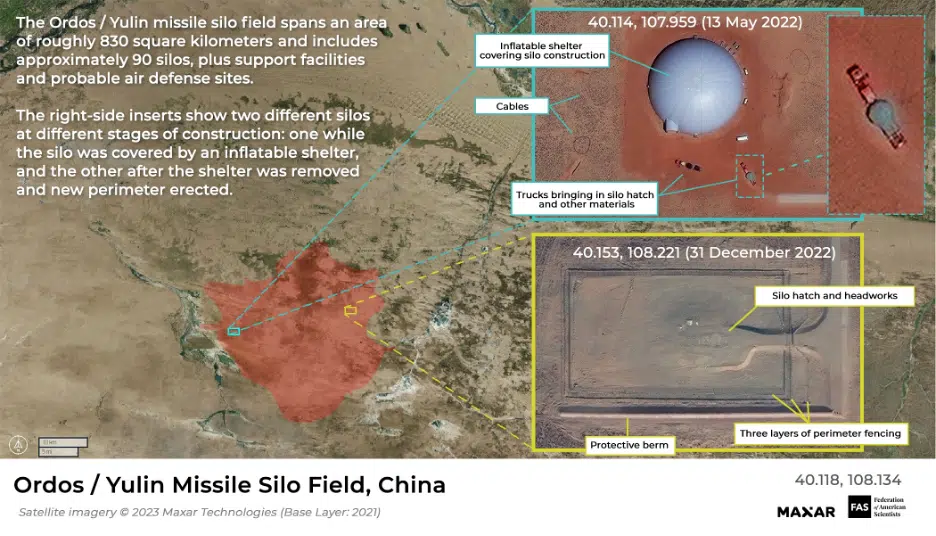
China’s ICBM force structure
In total, these discoveries indicate that China might be constructing approximately 320 new silos for solid-fueled ICBMs across these three fields, not including approximately 15 training silos at Jilantai. In addition, China is upgrading and expanding the number of silos for the liquid-fueled DF-5 ICBM and increasing the number of DF-5 launchers per brigade (US Department of Defense 2022a, 100). This includes additional silos at some of the existing DF-5 brigades and a whole new regiment with 12 silos in southeast Hubei province (Figure 4).
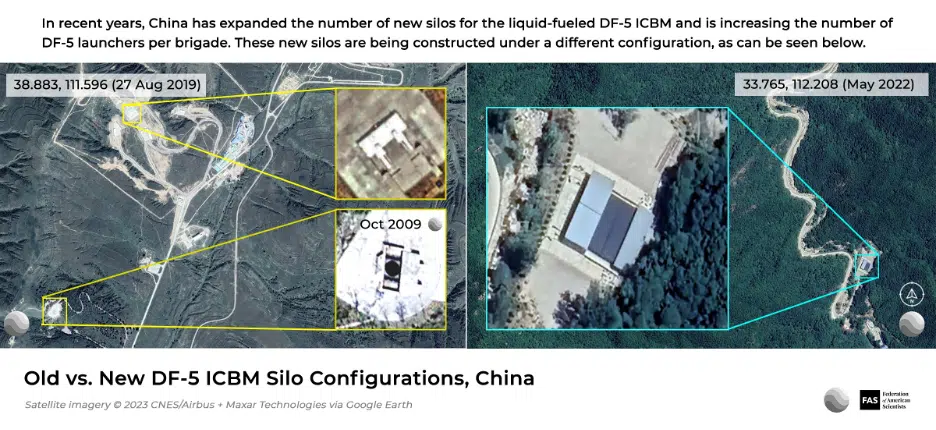
Combined, these construction efforts for silo-based ICBMs (in addition to new road-mobile ICBM bases) constitute the largest expansion of the Chinese nuclear arsenal ever. The number of new Chinese silos under construction exceed the number of silo-based ICBMs operated by Russia and constitutes about three-quarters the size of the entire US ICBM force.
In addition to the construction of new ICBM facilities, there is considerable uncertainty about how many ICBMs China currently operates. The US Department of Defense’s 2022 report about China’s military and security developments assessed that, at the end of 2021, China had 300 ICBM launchers with as many missiles in its inventory (US Department of Defense 2022a, 95, 167). The previous report from 2021 listed 100 launchers with 150 missiles as of the end of 2020 (US Department of Defense 2021, 163). We are not aware of public evidence confirming that China fielded 200 additional ICBMs launchers with an additional 150 missiles in one year. This Nuclear Notebook estimates that the PLARF currently possesses about 140 operational ICBM launchers. This suggests that the Pentagon possibly was including a significant number—but not all—of China’s new silos under construction in its ICBM launcher estimate.
Altogether, this Nuclear Notebook assesses that the total number of Chinese ICBM launchers—including mobile, silo, and training launchers, both operational and under construction—exceeds 450. This number triggered the notification from US Strategic Command to Congress in December 2022 that at least one of three ICBM force estimate categories (“active ICBM inven- tory,” “number of nuclear warheads on ICBMs,” and “ICBM launchers”) had recently surpassed the US inventory (which accounts for 450 ICBM launchers, including 50 empty “warm” silos) (Inhofe 2022). US Strategic Command subsequently clarified that the notification specifically referred to the number of ICBM launchers, and that the numbers of both Chinese ICBMs and ICBM warheads both remained below US levels as of October 2022 (US Department of Defense 2023).
It is unclear what criteria the Pentagon is using to assess the completeness of a silo, but in order to reach 450 launchers as of October 2022, US Strategic Command would have to count nearly all the silos in the three new missile silo fields. It is possible that the removal of the inflatable shelters at each construction site could constitute such criterion as this event is clearly observable through satellite imagery. We are not aware of any public information that suggests that silos at the three silo fields are operational or loaded with missiles despite the domes having been removed. Although we cannot rule out that some silos may be considered complete (but not yet loaded with missiles), satellite imagery indicates that the three fields are likely to still be several years away from full operational capability.
Assuming each construction site yields a new silo, and that each new silo will be filled with a single-warhead missile, the number of warheads on Chinese ICBMs could potentially increase to approximately 500 warheads within the next decade, twice as many as today. In addition, if all of the new silos were loaded with DF-41 ICBMs (each carrying up to three warheads), then the Chinese active ICBM force could potentially carry approximately 1,200 warheads once all three silo fields are completed. However, it is currently unknown how China will operate the new silos—whether silos will be loaded with DF-31A, DF- 41, or a mix of the two missile types; whether all silos will be filled; and how many warheads each missile will carry. Regardless, the sheer number of silos will likely have a significant effect on US strike planning against China.
At this stage of construction, it is unclear how these hundreds of new silos will alter the existing brigade structure for China’s missile forces. Presently, each of China’s ICBM missile brigades is responsible for six to 12 launchers. If this structure remains constant for the new silo fields, then China would need to add between 26 and 53 new brigades to accommodate them. Such development would pose potential challenges to the Chinese military: This structure could potentially double the number of existing brigades, and the new silos are located far from existing operations bases; this would likely stretch them too thin to accommodate the new fields. As a result, some analysts have hypothesized that the new silo fields could lead to the creation of entirely new PLARF “Bases”—an extremely rare event that has not taken place in more than 50 years (Xiu 2022, 255). For now, the Pentagon’s 2022 report on China shows the Hami and Yumen missile silo fields as “Missile Brigades” in the Western Theater organized under Base 64, and the Yulin missile silo field as a “Missile Brigade” in the Northern Theater organized under Base 65 (US Department of Defense 2022a, 116, 119).
Although China has deployed ICBMs in silos since the early 1980s, building missile silos on this scale is de facto a significant shift in China’s nuclear posture. The decision to do so has probably not been caused by a single event or issue but, rather, by a combination of strategic objectives and operational capabilities, including protecting the retaliatory capability against a first strike, overcoming the potential effects of adversarial missile defenses, better balancing the ICBM force between mobile and silo-based missiles, increasing China’s nuclear readiness and overall nuclear strike capability to account for improvements in the Russian, Indian, and US nuclear arsenals, as well as elevating China to a world-class military power.
Additionally, the shift in emphasis toward silo-based missiles could be tied to China’s longstanding transition from older, transportable, liquid-fuel, slow-launching missiles to longer-range, solid-fuel, quicker-launching missiles. China’s last liquid-fueled mobile ICBM—the DF-4 (CSS-3)—is probably being retired and the brigade upgraded to a newer missile type. Even so, China simultaneously continues to upgrade and expand its force of liquid-fueled, silo-based DF-5 ICBMs. Previously, China maintained approximately 18 DF-5 silos across three brigades (631, 633, and 661), plus two additional training silos near Wuzhai. Aside from being visible on satellite imagery, the estimate of “approximately 20” silos has been echoed several times by US government officials, including during congressional hearings relating to the 1999 Cox Report as well as in the Pentagon’s 2004 China Military Power Report (Cox 1999; US Department of Defense 2004, 37).
In recent years, however, China has begun to expand the number of DF-5 silos in its inventory, adding silos to existing brigades and adding at least one new brigade (US Department of Defense 2022a, 100). Several silos are under construction in the 662 Brigade area in western Henan province, and at least 12 silos are under construction as part of the new 634 Brigade in the southwest part of Hubei province, first reported by Ben Reuter (Reuter 2022) (Figure 5). These developments are still unfolding, and therefore the full scope of China’s DF-5 modernization remains unclear.
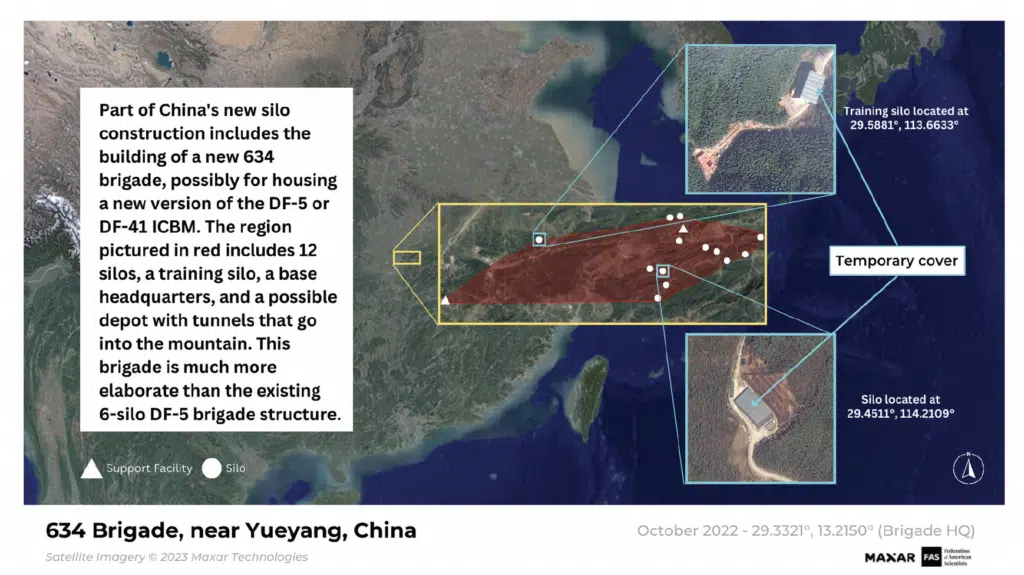
Currently two versions of the DF-5 are deployed: the DF-5A (CSS-4 Mod 2) and the MIRV’ed DF-5B (CSS-4 Mod 3). A third version known as DF-5C appears to be in development. The Pentagon’s 2020 report to Congress noted that the DF-5B can carry up to five MIRVs (US Department of Defense 2020a, 56). We estimate that two-thirds of the DF-5s are currently equipped to carry MIRVs, although it is possible that China intends to equip all of them with MIRVs.
In addition to these developments in the silo-based ICBM force, China debuted its first solid-fuel road-mobile ICBMs in 2006 with the DF-31 (CSS-10 Mod 1). It is a three-stage, road-mobile missile that is transported in a 15-meter canister on a six-axle transporter erector launcher. The DF-31 has a range of about 7,200 kilometers (km) but cannot reach the continental United States from its deployment areas in China.2 It is presumed to have taken over much of the regional targeting (of Russia, India, and Guam) previously done by the DF-4. Currently, China has only a single DF-31 brigade deployed, with 6 launchers that might soon be upgraded to the new DF-31AG.
The DF-31A (CSS-10 Mod 2) is an extended-range version of the DF-31, but with an apparently identical launcher. With a range of 11,200 kilometers, the DF- 31As can reach about half of the continental United States from most deployment areas. Each DF-31A brigade used to operate just six launchers but some have recently been upgraded to 12 (Eveleth 2020a). In 2020, the National Air and Space Intelligence Center estimated the number of DF-31A launchers to be more than 15 (National Air and Space Intelligence Center 2020, 29); however, given the number of bases observed with the launchers, we estimate that China now deploys about 24 DF-31As in two brigades. The DF-31A brigades are being upgraded to the new DF-31AG with improved maneuverability. According to the Pentagon’s most recent China report, Chinese media sources suggest that a DF-31B variant might be in development; however, no further information is given about the system (US Department of Defense 2022a, 65).
Since 2017, China’s road-mobile ICBM modernization effort has focused on replacing the DF-31s and DF- 31As with the DF-31AG and increasing the number of bases. The new launcher is thought to carry the same missile as the DF-31A but has improved off-road capability. The National Air and Space Intelligence Center’s most recent missile report listed the DF-31AG as having an “UNK” [unknown] number of warheads per missile, in contrast to the DF-31A, which was listed with only one warhead—suggesting that the AG version could potentially have a different payload (National Air and Space Intelligence Center 2020, 29). The Pentagon’s most recent China Military Power Report, however, implied that the DF-31AG was not MIRV-capable (US Department of Defense 2022a, 94). A 2018 Department of Defense report described the DF-31AG as “an enhanced version of the DF-31A ICBM that also uses a transporter erector launcher to increase its mobility and survivability” (US Department of Defense 2018b, 76). In September 2021, a report stated that personnel from the People’s Liberation Army Rocket Force’s DF-21- equipped 612 Brigade in southeastern China were training with the DF-31AG, indicating that the unit might be upgrading (Lee 2021a). The 2022 China Military Power Report noted that the number of launchers in mobile ICBM units is increasing from six to 12 (US Department of Defense 2022a, 95); however, this is only true for some of brigades, while some new bases appear to have eight launchers (Figure 6).
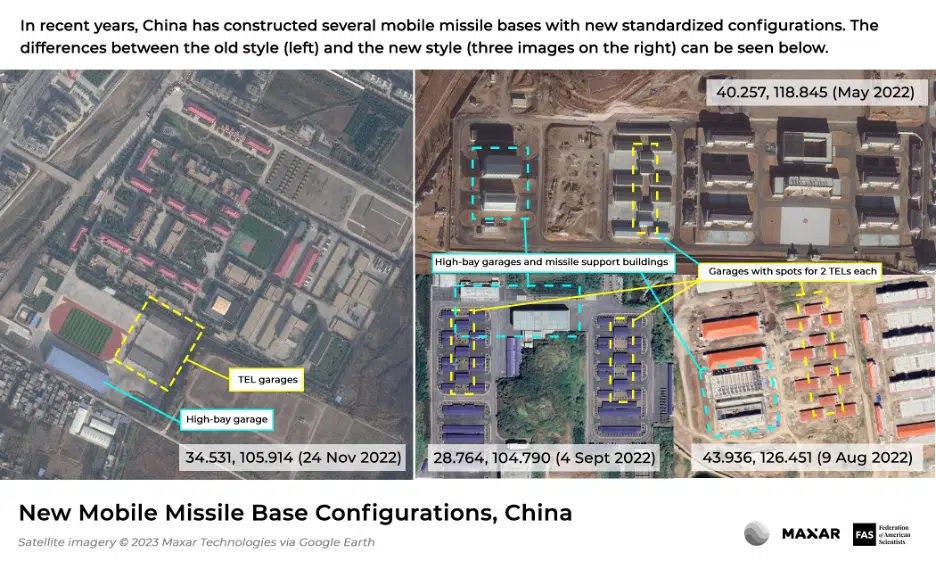
The next phase of China’s ICBM modernization is the integration of the long-awaited DF-41 ICBM (CSS-20) that began development back in the late 1990s. Eighteen DF-41s were mobilized for China’s 70th National Day parade in October 2019; the 16 that were displayed were said to come from two brigades (New China 2019). In April 2021, the commander of US Strategic Command testified to Congress that the DF-41 “became operational last year, and China has stood up at least two brigades” (Richard 2021b, 7). A third base may be nearing completion. The number of garages at the bases indicate that there may be approximately 28 DF-41 launchers deployed.
The US Department of Defense believes that this DF-41 can carry MIRVs, and rumors have spread in the media that the DF-41 can carry six to 10 warheads (US Department of Defense 2019, 45; Gertz 2016). Early rumors are often exaggerated, and the number of warheads that the DF-41 can carry is likely to be significantly lower. In previous Nuclear Notebooks we have estimated three MIRVs, which the Pentagon’s most recent China report appears to validate: “the system is likely intended to carry no more than three warheads per missile and has improved range and accuracy over DF-31 class ICBMs” (US Department of Defense 2022a, 94). It is unknown if all DF-41s will be equipped with MIRVs or if some will have only one warhead for maximum range. In addition to road-mobile launchers, the Pentagon says that China “appears to be considering DF-41 additional launch options, including rail-mobile and silo basing” (US Department of Defense 2022a, 65). The “silo basing” appears to refer to China’s new silos fields at Yumen, Hami, and Yulin.
China also appears to be developing a new missile, known as the DF-27, which reportedly has a range between 5,000 and 8,000 kilometers (US Department of Defense 2022a, 65). This range class is somewhat redundant for the nuclear strike mission, as these distances can already be easily covered by China’s longer-range ICBMs. It is therefore possible that the system could ultimately be used in a conventional strike role. US Indo-Pacific Command briefing in 2020 projected that China’s ICBM force by 2025 would include 50 missiles with so-called “hypersonic” payload (Minihan 2020, 7). Since all ICBM payloads reenter at hypersonic speed, the term may have referred to a conventional hypersonic glide vehicle. In September 2022, an unidentified missile vehicle matching the DF-27’s assumed length was spotted in Xinyu prefecture near the PLARF’s 635 Brigade (Lee 2022); however, it is also possible that the vehicle was a transporter or reloader for a different missile (Eveleth 2022).
On July 27 2021, China conducted a test of a new fractional orbital bombardment system (FOBS) equipped with a hypersonic glide vehicle, an event described as an unprecedented achievement for a nuclear-armed country (Sevastopulo 2021). According to the Pentagon, the system came close to striking its target after flying around the world, and “demonstrated the greatest distance flown (~40,000 km) and longest flight time (~100+ minutes) of any [Chinese] land-attack weapons system to date” (US Department of Defense 2022a, 65). A FOBS/HGV system would pose tremendous challenges for missile tracking and missile defense systems, as it could theoretically orbit around the Earth and release its maneuverable payload unexpectedly, although the US missile defense system is not intended to defend against Chinese missiles.
Medium- and intermediate- range ballistic missiles
For decades, the DF-21 missile family constituted China’s primary regional nuclear-capable system. The DF-21A (CSS-5 Mod 2) is a two-stage, solid-fuel, road-mobile, medium-range ballistic missile (MRBM) with a range of about 2,150 km (the unclassified range is 1,750 km). Since 2016, China has been fielding a new version, the CSS-5 Mod 6, possibly known as DF-21E. In recent years, several DF-21 brigades have converted—or are in the process of converting—to longer-range missile types, such as the DF-26 IRBM or the DF-31AG ICBM. We estimate that China has approximately 24 launchers for the nuclear DF-21A/E. China has also deployed two conventional versions: the DF-21C (CSS- 4 Mod 4) land-attack missile and the DF-21D (CSS-5 Mod 5) anti-ship missile. In addition to its ground-launched role, early indicators suggest that a variant of the DF-21D is also being integrated onto China’s H-6N bombers as an air-launched ballistic missile.
Over the past four years, the primacy of the DF-21 among China’s regional nuclear forces has been over- taken by the DF-26 (CSS-18) intermediate-range ballistic missile (IRBM) in significant numbers. The DF-26, which is dual-capable and launched from a six-axle road-mobile launcher, was first displayed during a parade in 2016, and the first brigade stood up in April 2018 outside Xinyang in Henan Province (Ministry of National Defense of the People’s Republic of China 2018). In its annual reports, the Pentagon stated that over the past several years, the DF-26 force has grown from 16 to 30 launchers in 2018, 80 launchers in 2019 (which probably was the upper end of a range estimate of 55 to 80), 200 launchers and “more than 200 missiles” in 2020, and 250 launchers and “250+” missiles by the end of 2021 (US Department of Defense 2022a, 167).
The DF-26 was first reported to be operating in a new training area in Inner Mongolia in January 2019 and has since been seen at several other brigades (Kristensen 2019a; Kristensen and Korda 2020a) (Figure 7). Given how the Pentagon counts other Chinese systems, it is possible that these estimates also included launchers in production. The operational number has almost certainly increased above 100 by now, possibly to at least 160 launchers in five or six brigades. China claims to have successfully tested the anti-ship variants of both the DF-21 and the DF-26 missiles against target vessels in August 2020 (Trevithick 2020).
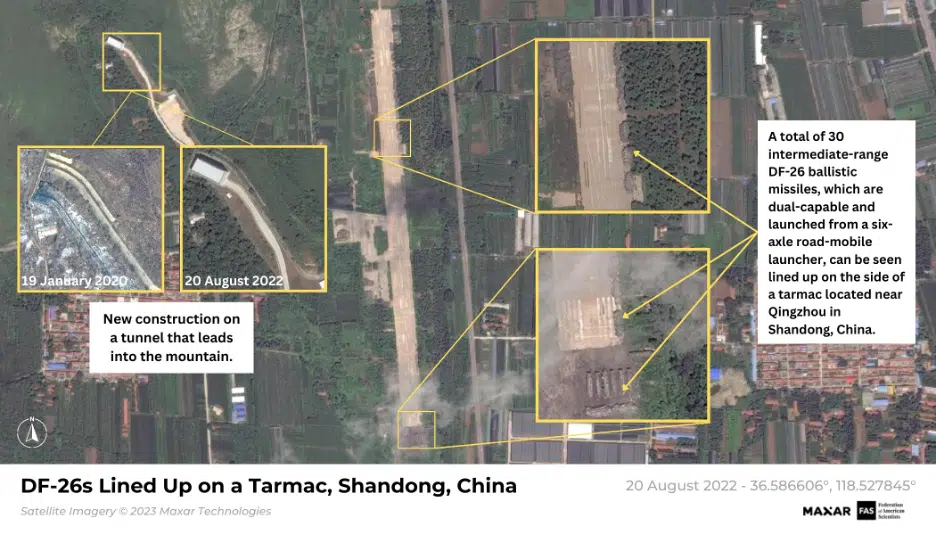
It seems unlikely that all dual-capable DF-26s serve a nuclear mission. The majority—including the anti-ship version—probably serve conventional missions with nuclear warheads only having been produced for use by a smaller number of the launchers. One brigade, the 646 Brigade at Korla, reportedly is tasked with both nuclear and conventional strike missions, the first time this type of dual mission had been confirmed within a single brigade (Xiu 2022, 129, 131). We cautiously estimate that perhaps one-third of the DF-26 launchers serve a regional nuclear role alongside the DF-21. Five or six DF-26 brigades appear to be operational, with more in the process of standing up (see Table 2).
Like the DF-4 and DF-31 ICBMs, the 4,000-kilometer range DF-26 can target important US bases in Guam. Unlike the DF-4 and DF-31, however, the DF-26 is both dual-capable and more accurate, and so provides China with its first precision nuclear strike capability, although it should be emphasized that precision is primarily a conventional requirement. The 2020 Pentagon report notes that there is also an anti-ship variant of the DF- 26 (US Department of Defense 2020a, 73).
The dual-capable role of the DF-26 raises some thorny issues about command and control and the potential for misunderstandings in a crisis. Preparations to launch (or the actual launch of) a DF- 26 with a conventional warhead against a US base in the region could potentially be misinterpreted as the launch of a nuclear weapon and trigger nuclear escalation (or even preemption). The mixing of nuclear and conventional capability on medium- and intermediate-range ballistic missiles has been implemented in China, India, and Pakistan. Citing a 2017 Chinese defense industry publication, the US Department of Defense hypothesized in 2022 that the DF-26 could eventually be used to field a lower-yield warhead (US Department of Defense 2022a, 98–99). Other than vague descrip- tions in Chinese military publications, there is no concrete public evidence that China necessarily plans to field a new low-yield nuclear capability. Moreover, although a “lower-yield” warhead may be less powerful than a higher-yield warhead, it is not necessarily the same as an explicitly “low-yield warhead.”
The 70th National Day parade in October 2019 saw the debut of China’s DF-17 (CSS-22) hypersonic boost-glide missile. Sixteen launchers were displayed and presented by the parade announcer as serving a conventional role in the People’s Liberation Army Rocket Force’s mission (New China 2019). However, unofficial sources connected to the Chinese defense industry have claimed that the missile will be dual-capable (Huang 2019), and during Senate testimony the commander of US Strategic Command listed the DF-17 as a “strategic nuclear system” (Richard 2020a, 4). The Pentagon’s most recent China report noted that “While the DF-17 is primarily a conventional platform, it may be equipped with nuclear warheads” (US Department of Defense 2022a, 65). The China Aerospace Studies Institute at the US Air University lists the DF-17 as conventional (Xiu 2022, 65).
The Pentagon assesses that the DF-17 has been operationally deployed, and the system is currently being integrated into several brigades, possibly replacing some legacy short-range ballistic missiles (US Department of Defense 2022a, 65, 83). Each DF-17 brigade may have 18 to 36 launchers, depending on maturity. Between 2020 and 2022, the Pentagon’s estimates of the PLARF’s MRBM force grew from 150 launchers and over 150 missiles to 250 launchers and over 500 missiles. This dramatic increase is primarily due to the deployment of the DF-17 to multiple brigades, in many cases replacing legacy short-range ballistic missiles (US Department of Defense 2020a, 166; 2022a, 167). We estimate the DF-17 is deployed with at least two brigades (614 and 627) and being integrated into three or four more.
Short-range ballistic missiles
Despite many unsubstantiated rumors to the contrary, we estimate that all of China’s short-range ballistic missiles (SRBMs) are conventional. In the early 1990s, the CIA concluded that a nuclear warhead had been developed for the DF-15 (CSS-6), but it was probably never fielded. After reporting that the nuclear test China conducted on August 16 1990, may have been “related to development of a warhead for a Chinese short-range ballistic missile” (CIA 1990, 1), the CIA concluded three years later “that China will begin to field nuclear-armed CSS-X-6s next year.” The 1993 memorandum went on: “China almost certainly has already developed the warhead for this system. Testing might be needed for formal weaponization or for additional warhead options” (CIA 1993, 5). Despite the apparent nuclear capability China developed at that time, though, it is unclear whether it ever completed it, the missile was apparently never fielded. The 2022 Department of Defense report to Congress lists the DF-15 as a conventional missile (US Department of Defense 2022a, 64). There are three known missiles in the DF-15 missile family, known as the DF-15A, DF-15B, and DF-15C.
Notably, the Pentagon’s 2022 assessment of Chinese SRBMs decreased from 250 to 200 since the previous year’s assessment (US Department of Defense 2022a, 167). This is likely because several PLARF brigades are upgrading from legacy SRBMs to DF-17 MRBMs.
Submarines and sea-based ballistic missiles
China currently fields a submarine force of six Jin-class (Type 094) nuclear-powered ballistic missile submarines (SSBNs), which are based at the Longposan naval base near Yulin on Hainan Island. The two newest SSBNs are believed to be variants of the original Type 094 design and are known as the Type 094A. The Type 094A boats include a more prominent hump, which initially triggered some speculation as to whether they could carry up to 16 submarine-launched ballistic missiles (SLBMs), instead of the usual 12 (Sutton 2016; Suciu 2020). However, satellite images confirmed that the new subs are equipped with 12 launch tubes each (Kristensen and Korda 2020a).
The Jin-class was originally equipped to carry the 7,200-kilometer range JL-2 (CSS-N-14) SLBM, but in November 2022, the commander of the US Pacific Fleet told reporters the submarines were equipped with the longer-range JL-3 (CSS-N-20) SLBMs (Capaccio 2022). The range of the JL-2 was sufficient to target Alaska, Guam, Hawaii, Russia, and India from waters near China, but not the continental United States—unless the submarine sailed deep into the Pacific Ocean to launch its missiles. With its longer range of roughly 10,000 kilometers (National Air and Space Intelligence Center 2020, 33), a submarine will be able to target the northwestern parts of the continental United States from Chinese waters, but it would still not be able to target Washington, DC without sailing past northeast Japan. Chinese media sources describe the JL-3 as “equivalent to or similar to the French M51” SLBM, and note that it has a larger diameter than the JL-2 and includes a carbon fiber casing, which will allow for an extended range (Coates 2020). Unlike the JL-2, the JL-3 can deliver “multiple” warheads per missile (National Air and Space Intelligence Center 2020, 33). The People’s Liberation Army Navy reportedly conducted its first test of the JL-3 in November 2018 (Gertz 2018) and appears to have conducted at least two additional tests since then. The JL-3 is also expected to be incorporated onto China’s next-generation of SSBNs.
Although the Jin-class is more advanced than China’s first experimental SSBN—the single and now inoperable Xia (Type 092)—it is a noisy design compared with US and Russian missile submarines; it is suspected that the Type 094 remains two orders of magnitude louder than the top Russian or American SSBNs (Coates 2016). For that reason, China would continue to face constraints and challenges when operating its SSBN force in a conflict (Kristensen 2009a). It therefore seems likely that China will end production after its now-completed six boats and turn its efforts to developing the quieter third-generation (Type 096) SSBN, which was scheduled to begin construction in the early 2020s. The completion of a new construction hall at Huludao, where the People’s Liberation Army Navy’s submarines are built, indicated that work would soon begin on the Type 096, which is expected to be larger and heavier than the Type 094 (Sutton 2020). Satellite images show wider hull sections at Huludao, indicating that production of a larger submarine may have started (Sutton 2021), although it is not clear whether it corresponds to a new attack submarine or the larger Type 096 SSBN. Some anonymous defense sources have speculated the Type 096 will carry 24 missiles (Chan 2020), but there are no public official sources confirming this information. Current and projected missile inventories seem to indicate that the SSBN will more likely carry 12 to 16 missiles.
Given that China’s SSBNs are assumed to have a service life of approximately 30 to 40 years, the US Department of Defense expects that the Type 094 and Type 096 boats will operate concurrently (US Department of Defense 2022a, 96). If confirmed, this could potentially result in a future fleet of eight to 10 SSBNs. Satellite images show the construction of additional submarine piers at the submarine base on Hainan Island (Figure 8).
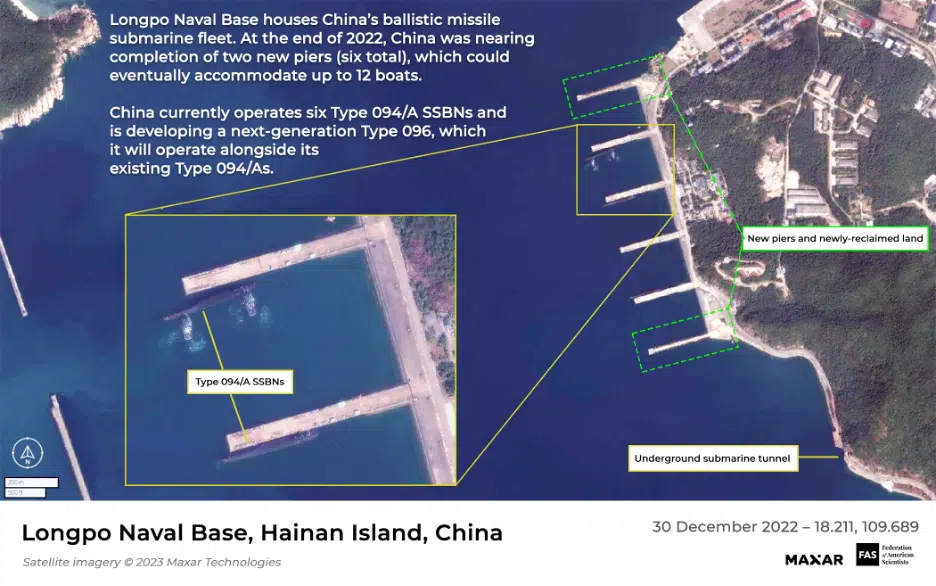
Fifteen years after the first Jin-class submarine was launched, the Pentagon says China “likely began near-continuous at-sea deterrence patrols with its six JIN class SSBNs” in 2021 (US Department of Defense 2022a, 96). The term “near-continuous” implies that the SSBN fleet is not on patrol all the time but that at least one boat is deployed intermittently. The term “deterrence patrol” could imply that the submarine at sea may have nuclear weapons onboard, although the wording is not definitive. Giving custody of nuclear warheads to deployed submarines during peacetime would constitute a significant departure from Chinese declaratory policy and a significant change for China’s Central Military Commission, which has historically been reluctant to hand out nuclear warheads to the armed services.
To fully develop a survivable sea-based nuclear deterrent posture, China must have a reliable command and control system that ensures reliable communication with the SSBNs when needed and prevents the crew from launching nuclear weapons without authorization. Moreover, the SSBN fleet will have to operate safely in patrol areas from where its missiles can reach intended targets. Western military officials have privately stated that the United States, Japan, Australia, and the United Kingdom “are already attempting to track the movements of China’s missile submarines as if they are fully armed and on deterrence patrols” (Torode and Lague 2019). Whenever they put to sea in this region, China’s SSBNs typically appear to be accompanied by a protection detail, including surface warships and aircraft (and possibly attack submarines) capable of tracking adversarial submarines (Torode and Lague 2019).
Given the noise level of the SSBNs, it seems likely that China during conflict would keep the submarines inside a protected “bastion” in the South China Sea (US Department of Defense 2022a, 96). But even with the JL-3 SLBM, the SSBNs would not be able to target the continental United States from the South China Sea. To do that, they would have to sail far north. Even if they patrolled inside the Bohai Sea, the missiles would only be able to target the northwestern parts of the continental United States—not Washington, DC.
Bombers
China developed several types of nuclear bombs and used aircraft to deliver at least 12 of the nuclear weapons that it detonated in its nuclear testing program between 1965 and 1979. But the People’s Liberation Army Air Force (PLAAF) nuclear mission remained officially dor- mant well into the 2000s, not least because its older intermediate-range bombers were unlikely to be useful in the event of a nuclear conflict. In 1993, the US National Security Council informed Congress: “The Chinese Air Force has no units whose primary mission is to deliver China’s small stockpile of nuclear bombs. Rather, some units may be tasked for nuclear delivery as a contingency mission” (National Security Council 1993, 2). As late as 2017, the US Department of Defense assessed that the “People’s Liberation Army Air Force [did] not currently have a nuclear mission” (US Department of Defense 2017, 61).
Coinciding with a renewed emphasis on nuclear aircraft modernization, the US Department of Defense reported in 2018 that the People’s Liberation Army Air Force “has been newly re-assigned a nuclear mission” and that the “H-6 and future stealth bomber could both be nuclear capable” (US Department of Defense 2018b, 75, 34). The 2019 report references unidentified “Chinese media” sources that have apparently labeled the upgraded H-6K as a “dual nuclear-conventional bomber” since 2016 (US Department of Defense 2019, 41). The US Department of Defense’s Nuclear Matters Handbook from February 2020 listed the H-6 as nuclear and “completely fielded within 10 years” (US Department of Defense 2020b, 3). We estimate that for years China has maintained a small inventory of gravity bombs—perhaps up to 20—for potential contingency use by aircraft, even though it only recently has begun to reassign a formal nuclear mission to People’s Liberation Army Air Force units.
In addition to the gravity bombs, the Defense Intelligence Agency reported in 2017 that China was developing two air-launched ballistic missiles for the H-6 bomber, “one of which might include a nuclear payload” (Stewart 2017). It is unclear whether these two missiles are wholly distinct systems, or whether they are largely the same system with an alternate war- head configuration. The missile appears to bear resemblance to China’s DF-21 MRBM, indicating that a conventional variant could have a long-range anti-ship capability, similar to that of the DF-21D variant (Panda 2019; Newdick 2022). The nuclear-capable version, designated by the United States as CH-AS-X-13, will be carried by yet another modification of the H-6 bomber known as the H-6N BADGER, which made its debut appearance at the October 2019 parade and has entered service with the People’s Liberation Army Air Force. The H-6N’s appearance is distinct from that of the H-6K dual-use bomber in that it is equipped with a nose-mounted in-flight refueling probe (Rupprecht 2019), and includes a modified fuselage that the US Department of Defense states can accommodate the nuclear-capable air-launched ballistic missile or possibly a drone (US Department of Defense 2022a, 50). Notably, the airframe modification includes the removal of the bomb bay, indicating that if a legacy gravity bomb capability still existed for the PLAAF, the H-6N would not be part of that contingency mission.
One of the first bomber units to get an operational nuclear capability might be the 106th Brigade at Neixiang Air Base in the southwestern part of Henan province; civilian video footage from October 2020 appears to show an H-6N bomber flying with the possible new air-launched ballistic missile just outside of Neixiang Air Base, which also appears to be one of China’s only airfields with an adjacent air defense site (Lee 2020a, 2020b; Rupprecht and Dominguez 2020).
The air-launched ballistic missile in development was first tested in December 2016 and at least five times by April 2018 (Panda 2019). In 2019, a US intelligence community source told The Diplomat that the missile would be ready for deployment by 2025 (Panda 2019). This fits the US Department of Defense’s early-2020 estimate that a “TBD [name to be determined] ALBM [air-launched ballistic missile]” is “in research & development within 10 years” (US Department of Defense 2020b, 3). Once complete, this nuclear air-launched ballistic missile will, “for the first time, provide China with a viable nuclear ‘triad’ of delivery systems dispersed across land, sea, and air forces” (US Department of Defense 2019, 67).
To replace the H-6, China is developing a bomber with longer range and improved capabilities. US officials have stated that the new bomber, known as H-20, will have both a nuclear and conventional capability and may be revealed sometime in the next decade (Coats 2018, 7; US Department of Defense 2022a, 83). After China’s 2022 International Aviation and Aerospace Exhibition (also known as Airshow China 2022), a former PLA instructor indicated that the H-20 was still a technical requirement for PLAAF’s upgrade of its nuclear triad (Chan 2022), and some sources indicate test flights could happen soon though the timing remains highly uncertain (Trimble 2022).
Cruise missiles
From time to time, various US military publications have asserted somewhat vaguely that one or more of China’s cruise missiles might have nuclear capability. However, we continue to assess that although China might have developed warhead designs for potential use in cruise missiles, it currently has no nuclear cruise missiles in its active stockpile.
The CIA concluded in 1995 that a Chinese test scheduled for that year “may include warhead testing for . . . a cruise missile” (CIA 1995). In 2013, a US Air Force Global Strike command briefing listed the CJ-20 air-launched land-attack cruise missile carried by the H-6K as possibly dual-capable (Kristensen 2013). Likewise, in 2009 the US Air Force described the DH-10 (now called DF-10) ground-launched cruise missile as “conventional or nuclear,” but in 2017 designated it and all other Chinese air-launched land-attack cruise missiles “conventional” (National Air and Space Intelligence Center 2017, 37). Even so, a nuclear modernization fact sheet published by the Pentagon in connection with the release of the 2018 Nuclear Posture Review claimed, without identifying them, that China had both air-launched and sea-launched nuclear cruise missiles (US Department of Defense 2018a). We are not aware of any confirmation of that claim. It is possible, but unconfirmed, that the future H-20 could be equipped with a nuclear cruise missile.
Endnotes
[1] Nuclear weapons are stored in central facilities under the control of the Central Military Commission. Should China come under nuclear threat, the weapons would be released to the Second Artillery Corps to enable missile brigades to go on alert and prepare to retaliate. For a description of the Chinese alerting concept, see Kristensen (2009b). For more on warhead storage in China, see Stokes (2010). For an overview of the People’s Liberation Army Rocket Force structure and organization, see Stokes (2018) and Xiu (2022). For an insightful overview of Chinese thinking about nuclear weapons and policies, see Santoro and Gromoll (2020).
[2] The “continental United States” as used here includes only the lower 48 states. US states and territories outside of the continental United States include Alaska, Hawaii, Guam, American Samoa, Puerto Rico, the US Virgin Islands, and many tiny Pacific islands.
Disclosure statement
No potential conflict of interest was reported by the authors.
Funding
This research was carried out with generous contributions from the John D. and Catherine T. MacArthur Foundation, the New-Land Foundation, Ploughshares Fund, the Prospect Hill Foundation, the FTX Future Fund and Longview Philanthropy, the Stewart R. Mott Foundation, the Future of Life Institute, and individual donors.
Together, we make the world safer.
The Bulletin elevates expert voices above the noise. But as an independent nonprofit organization, our operations depend on the support of readers like you. Help us continue to deliver quality journalism that holds leaders accountable. Your support of our work at any level is important. In return, we promise our coverage will be understandable, influential, vigilant, solution-oriented, and fair-minded. Together we can make a difference.
Keywords: China, Nuclear Notebook, ballistic missiles, bombers, delivery systems, nuclear arsenal, nuclear risk, nuclear weapons
Topics: Nuclear Notebook, Nuclear Risk, Nuclear Weapons
